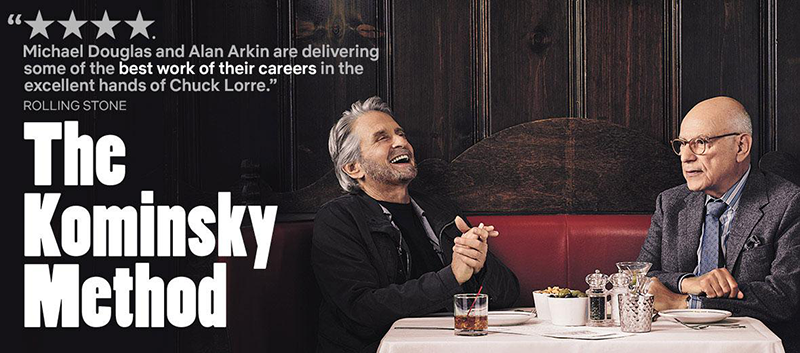
By Stuart Greenbaum and Kathryn Cherkas
Who better to judge whether art accurately imitates life than those with plenty of experience? So, when Hollywood attempts to fictionalize aging-related storylines, it would make sense — practically and experientially — for creative content developers to, well, consider the source, as in real older adults.
Older adults can provide studios with a reality check concerning the authentic representation of everything longevity. Moreover, there’s a financial incentive to favoring this demographic, which happens to be a rapidly increasing population who enjoy consuming small and big screen entertainment.
Fortunately for Hollywood, when coming of age matters, a fount of knowledge resides just up the PCH. Where an intrepid group of a dozen or so 70-, 80- and 90-year-olds gather monthly in the rec room of Friendship Center Adult Day Services in Montecito, California near Santa Barbara, to critique what the industry has to offer mature audiences.
JOURNEY, METHOD AND GRACE
This past month the critics binged purposefully on “The Hundred-Foot Journey,” the Harpo Films 2014 feature, and several episodes of two current Netflix series, “The Kominsky Method” and “Grace and Frankie.”
Beyond being entertained, a deliberate challenge for the group is finding the balance of “normal” individuals who are aging “normally.” It seems reality rarely coincides with fiction, according to these experienced critics, whose consensus is that most older adults have neither the resources nor capacity to socialize, work and engage in the busy lives depicted by the three projects.
The group, however, lauded “The Hundred-Foot Journey” storyline for featuring not one but two older adults — Madame Mallory, played by Helen Mirren, 74, and Om Puri (1950-2017) in the role of Papa. Both characters, the critics appreciated, represented genuinely complex personalities — ranging from stubborn to shrewd to charming. Overall, the film earned a thumbs up from the group.
On the small screen, the critics particularly liked the role played by Alan Arkin, 85, on “The Kominsky Method.” Norman Newlander is somewhat of a lost soul after the passing of his beloved wife upon whom he had grown incredibly dependent. “He’s a combination of sad and dazed and questioning the point of going on alone,” one viewer summarized. “He does all this with an even mannered, realistic attitude as opposed to a younger man who would likely deal with this with more extreme behaviors.”
As widows and widowers themselves, the critics delved further still into love and life and loss. “We often see death as something tragic in film, but many of us didn’t lose our partners like that,” another viewer observed. “Most of us spent our lives with someone we love and walked with them until the end.” The truth is, all agreed, with this later kind of death you don’t feel sadness like you might’ve earlier in life. “You feel empty. It can be quite boring when you lose a spouse after spending so many decades together.”
Time can become the enemy to surviving spouses. Which is why companionship not just condolences is so important. The writers of “The Kominsky Method” get this, determined the viewers, who were quick to recognize that their gathering to watch the show is healthy, too.
Commendable as well was how “The Kominsky Method” covered the issue of abandonment by friends as older adults’ health declines. This includes the personal fear shown by the Michael Douglas character Sandy Kominsky of his own mortality and of seeing his friends passing away. “The Kominsky Method” also got a thumbs up, with an expressed interest to watch more episodes.
The popular Netflix series “Grace and Frankie” fared less well with this cohort. “The show tries too hard to make aging look positive,” one critic suggested. “No one in their seventies can actually look like that without a huge wallet,” another remarked. All agreed the relationships among family members were unrealistic. “In my experience, very few people that age, especially women, can live such glamorous lives,” said one female reviewer, adding, “Watching this just makes me feel old.” By contrast, none minded the sexual references, though several found the harsh language occasionally offensive and inappropriate. A collective thumbs down, the group conceded.
The Friendship Center’s film and TV reviewing project is co-sponsored by the Wise Up On Aging initiative, which is supported by the California Commission on Aging. The goal of the initiative is to encourage Hollywood’s content developers to authentically represent aging and older adults. The intent of sharing the mature critiques of the group assembled by the Friendship Center is to inform and influence such direction.
Stuart Greenbaum is director of the Wise Up On Aging initiative and a Governor’s appointed to the California Commission on Aging. Kathryn Cherkas, MPH, is program manager at the Friendship Center for adult day services in Santa Barbara, where she coordinates the film and TV viewings.







I love the fact that they recognize that Jane Fonda had some work done. The line that touched me the most was, “It can be quite boring when you lose a spouse after spending so many decades together.” Also recognizing how often the elderly are losing friends. This is definitely happening with my mom.